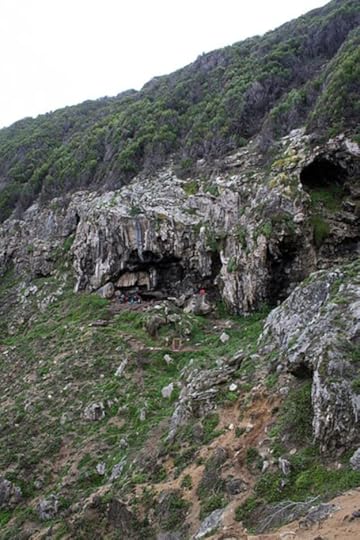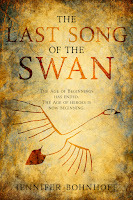Ochre: An Ancient and Powerful Color
Humans have been engaging in art for a long, long time. Oneof the earliest colors that these artists used is a vibrant red called ochre. Ancientpeople used it for painting walls, and possibly their skin and clothes. Thefact that they often covered burials with ochre suggests they may have believedit to have magical properties.
 Marco Almbauer, CC BY-SA 3.0
Marco Almbauer, CC BY-SA 3.0 <https://creativecommons.org/licenses/...,
via Wikimedia CommonsOchre(pronounced OAK-er) is a soft, clay-like rock that is pigmented by hematite, areddish mineral that contains oxidized iron. It can be ground and mixed withwater to make a paint. Since ochre is a mineral, it doesn’t fade or decay with time,allowing its vibrant color to last over the millennia.
Theuse of ochre is even older than man. A Homo erectus site in Kenya calledGnJh-03 provides the earliest evidence of ancient humans using ochre. Archaeologistsfound about 70 pieces of ochre weighing about 11 pounds at this site, whichdates to about 285,000 years ago.
At an early Neanderthal site in the Netherlands called Maastricht-Belvédère,archaeologists excavated small concentrates of ochre, which they believe was powderedand mixed it with water so that they could paint their skin or clothing.
LaPasiega, a cave in northern Spain, has ochre paintings, including this one of ahorse. The paintings are estimated to date to at least 64,000 years ago and itis believed they were created by Neanderthals. Lawrence Straus, a distinguishedprofessor emeritus of anthropology at the University of New Mexico disagreeswith both the dating and the attribution of the paintings, arguing that Neanderthalsmight have used ochre to make non-representational paintings, such as lines anddots, but that it's debatable whether they made more complex cave paintings,such as illustrations of animals or human figures.
Gobierno de Cantabria, CC BY 3.0<https://creativecommons.org/licenses/..., via Wikimedia Commons
 Vincent Mourre / Inrap, CC BY-SA 3.0
Vincent Mourre / Inrap, CC BY-SA 3.0 via Wikimedia Commons
Blombos Cave, in South Africa shows some of the earliestuses of ochre by modern humans. A small rock flake has a red ochre hashtag on itthat was probably painted about 73,000 years ago.
Ancient use of ochre is widespread, and is documented in Africa,Europe, the Middle East, Southeast Asia, Russia and Australia. When peoplecrossed over the Bering Strait land bridge from Siberia and East Asia to theAmericas, it appears they brought ochre with them. Once they were here, theycontinued to mine the soft stone. Powars II, a site in the southern RockyMountains of Wyoming, was first mined about 12,800 years ago. It is the onlyone of the five red- ochre quarries discovered in the Americas that is north ofMesoamerica.
Ochre was not only used for painting caves. One grave foundin Southern Wales, in the United Kingdom, in 1823 had a skeleton that had somuch ochre on it that archaeologists speculated that the skeleton must be theremains of an indecent, scarlet woman. It turns out that they were very wrong,and that the famous Red Lady of Paviland is actually the burial of a young manwho lived during the Paleolithic about 33,000 years ago. An Alaskan burial of two infants covered in ochre dates to about 11,500 years ago.
Ochremay have had practical applications as well. Some archaeologists argue that itwas as a sunscreen and to keep insects off the skin.Some archaeologists believe that because of its color, redochre is a symbol of blood and was used ceremonially for hunting success. Othersthink it was a symbol of life and fertility. Even today, the color red brings upstrong emotions. When someone says they are seeing red, it means they are veryangry. Red hearts are symbols of love. It’s no wonder that ochre has continuedto be used as a pigment throughout antiquity, medieval times, the Renaissance,and continues to be used today.

 Jennifer Bohnhoff is an author of historical and contemporary fiction for adults and middle grade readers. Her novel, The Last Song of the Swan is a dual timeline story set in the modern Southwest and in what is now Denmark, during the late Ice Age, when Neanderthals and Modern Humans both lived in the area. This spring, In the Shadow of Sunrise will be published. It is a story about a young man ready to go through the ceremonies that will prove him a man, and it's set in the Southwest 11,000 years ago, during the Folsom Period. Both books feature the use of ochre in paintings, burials, and hunting ceremonies.
Jennifer Bohnhoff is an author of historical and contemporary fiction for adults and middle grade readers. Her novel, The Last Song of the Swan is a dual timeline story set in the modern Southwest and in what is now Denmark, during the late Ice Age, when Neanderthals and Modern Humans both lived in the area. This spring, In the Shadow of Sunrise will be published. It is a story about a young man ready to go through the ceremonies that will prove him a man, and it's set in the Southwest 11,000 years ago, during the Folsom Period. Both books feature the use of ochre in paintings, burials, and hunting ceremonies.



